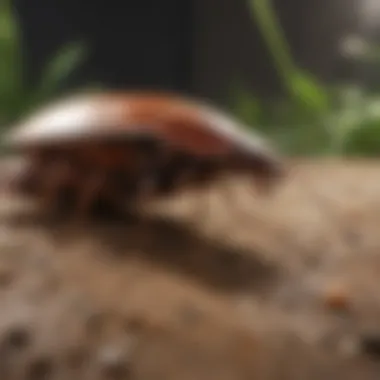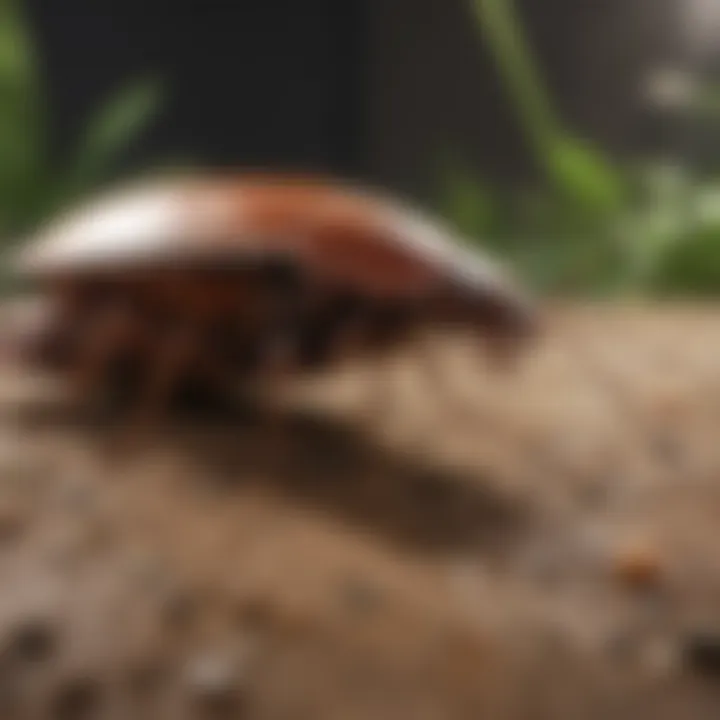Natural Ways to Eliminate Cockroaches Effectively


Intro
Cockroaches are among the most unwelcome pests in homes, prevalent in many regions. Their ability to survive in various conditions makes them resilient adversaries. While chemical solutions are common, they often pose risks to health and the environment. Therefore, whatever the reasons, eliminating roaches through natural methods becomes necessary.
This guide provides detailed insights into natural techniques for controlling cockroach populations. The focus lies on household ingredients, preventive measures, and sustainable practices. Homeowners will find it beneficial to adopt these approaches not only for pest control but also for creating a healthier living space.
Addressing this infestation fundamentally involves understanding not just how to eradicate roaches but also how to prevent their return.
Understanding Cockroach Behavior
Effective natural pest control begins with understanding the behavior of cockroaches. These pests are nocturnal, preferring dark, humid environments. They are omnivorous, often attracted to food scraps and garbage. This knowledge aids in developing comprehensive strategies that may include reducing potential food sources.
Common Species of Cockroaches
- German Cockroach: Small, light brown with two dark stripes on the back.
- American Cockroach: Larger, reddish-brown with a yellow margin on the thorax.
- Oriental Cockroach: Black, shiny, and prefers cooler climates.
Understanding the type of roach you are dealing with can help tailor your approach to pest management effectively.
Prevention Strategies
Preventing cockroach infestations involves practical steps to minimize their attractiveness to the home.
- Maintain Cleanliness: Regularly clean kitchens and areas where food is prepared. Ensure that no food residues are left behind.
- Seal Entry Points: Inspect your home for gaps, cracks, or holes, and seal them to prevent roach entry.
- Reduce Clutter: Cockroaches thrive in cluttered environments. Regularly de-cluttering living spaces can reduce potential hiding spots.
"An ounce of prevention is worth a pound of cure." - Benjamin Franklin
Natural Extermination Techniques
If cockroaches have already infested the space, several natural methods can help eliminate them effectively.
Diatomaceous Earth
Diatomaceous earth is a natural powder made from fossilized aquatic organisms. It works by dehydrating and damaging the exoskeletons of cockroaches. Simply sprinkle this powder in areas where you have seen roaches.
Boric Acid
Although it is a natural insecticide, caution is necessary. Mix boric acid with sugar water to attract roaches. Place small amounts in concealed areas. This method is effective but requires careful handling.
Essential Oils
Certain essential oils possess insect-repelling properties. Peppermint oil is known for its efficacy against cockroaches. Mix a few drops in water and spray it in areas where roaches are likely to appear.
Baking Soda and Sugar
A simple mixture of baking soda and sugar can be effective. The sugar attracts the cockroaches, while the baking soda kills them once ingested.
Maintenance and Monitoring
Once you have implemented extermination techniques, continuous monitoring is essential. Regular inspections help to identify any resurgence of pests. Keeping areas clean and maintained is fundamental to sustaining the progress achieved.
Prolusion to Natural Roach Control
Combating cockroaches in a home can be a challenging task. Understanding effective and natural methods is essential to maintaining a hygienic living environment. This section emphasizes the significance of natural roach control, aiming to equip homeowners with the knowledge to manage roach infestations without chemicals. By employing natural strategies, individuals can reduce reliance on harsh pesticides and contribute to a safer ecosystem. The benefits of this approach extend beyond immediate extermination; they include improved indoor air quality and a reduction in toxic exposure, making it a preferred choice for families and pets.
Understanding Cockroach Behavior
To effectively control roaches, one must first understand their behavior. Cockroaches are nocturnal creatures, often seeking warmth and food at night. They are attracted to moist areas, so kitchens and bathrooms are prime locations for infestations. Observing their patterns can aid in anticipating their movements and planning control measures accordingly. For instance, roaches thrive in clutter and can easily hide in dark corners. Recognizing when and where they typically appear can help in setting traps or applying natural repellents.
Additionally, cockroaches reproduce rapidly. A single female can produce hundreds of offspring during her lifetime. This highlights the urgency of addressing any signs of infestation swiftly. By understanding these dynamics, homeowners are better equipped to implement effective preventative and control strategies.
The Importance of Natural Solutions


The growing concern about chemical pest control methods has prompted many to explore natural alternatives. The importance of natural solutions goes beyond just pest elimination. Natural treatments utilize common household items such as vinegar, baking soda, or essential oils, which are often safer for both humans and the environment.
"Natural solutions protect your home and health simultaneously."
Furthermore, pest control through natural means can reduce long-term costs associated with ongoing infestations and chemical treatments. It also addresses the root causes of infestations by focusing on prevention rather than merely extermination. Adopting natural practices can lead to lasting effects, ultimately creating a more sustainable living space.
For homeowners, adopting these methods fosters a deeper connection to their living spaces. By understanding how to utilize household ingredients effectively, individuals empower themselves to maintain their homes with confidence and care.
Identifying Cockroach Species
Identifying the species of cockroach is a fundamental step in pest control. Each type has unique behaviors and habitat preferences. Understanding these traits can significantly shape your approach to managing an infestation. By knowing what species you are dealing with, you can choose the most effective natural extermination methods tailored to their specific needs and habits.
Knowing the cockroach species also helps in determining the severity of the infestation. Some species are more resilient, while others reproduce quickly. This understanding allows homeowners to take proactive steps. It is particularly valuable in crafting a comprehensive plan that incorporates preventive measures alongside extermination techniques.
Common Types of Cockroaches
There are several common types of cockroaches that invade homes. Here are the most notable:
- German Cockroach: This is one of the most frequently found cockroaches in homes. They are small, light brown, and prefer warm conditions, making kitchens ideal.
- American Cockroach: Larger than the German variety, these cockroaches are reddish-brown and can live outside as well. They often seek shelter in basements and drains.
- Oriental Cockroach: These are black and have a shiny appearance. They thrive in damp, humid areas such as basements.
- Brown-Banded Cockroach: Often mistaken for the German cockroach, these are smaller with distinct bands across their wings. They can often be found in unusual spaces like cabinets and high places.
By recognizing these species, you can pinpoint their habitats and behaviors, enhancing your pest control efforts.
Signs of Infestation
Detecting the signs of a cockroach infestation early can save you a significant amount of effort. Here are some common indicators:
- Droppings: Cockroach droppings are small and dark, resembling pepper or coffee grounds. This is often found in areas where they hide.
- Egg Cases: The egg cases or oothecae are brown and leathery. Finding them indicates the presence of breeding cockroaches.
- Musty Odor: A strong, unpleasant odor can be a telltale sign of a significant cockroach population.
- Signs of Damage: Cockroaches can chew through cardboard, paper, and even some plastics, leaving behind small holes.
If you notice these signs, it’s essential to act quickly. Ignoring them can lead to a larger infestation that becomes harder to control. Understanding these signs empowers homeowners to take immediate steps to address the problem.
Preventive Measures Against Roaches
Preventive measures are essential in managing cockroach populations efficiently. Proactive steps can significantly minimize the chances of infestation, making it easier to maintain a roach-free environment. Implementing preventive strategies helps ensure that cockroaches do not find your home as a suitable habitat. This is where understanding the methodical practices becomes crucial.
Maintaining Hygiene
One of the most effective ways to deter cockroaches is through strict hygiene practices. These pests thrive in environments where food and water are readily accessible. This includes food particles on the floor and leftover crumbs on countertops. Regular cleaning routines should be established for kitchens and living areas.
- Wipe down surfaces: Clean counters and tables daily using a suitable cleaning agent, ensuring that no food residue remains.
- Sweep and vacuum: Frequently sweep or vacuum floors to capture crumbs and debris.
- Store food properly: Keep food in airtight containers to prevent cockroaches from accessing it.
By prioritizing cleanliness, you physically reduce the necessities required for a roach infestation. This preventative measure is fundamental and requires minimal resources but can have a substantial impact.
Sealing Entry Points
Cockroaches are incredibly adept at entering homes through minuscule openings. Therefore, sealing potential entry points is vital in preventing an invasion. Identifying and closing these gaps not only stops roaches from coming in but also keeps other pests at bay.
- Inspect windows and doors: Check these structures for any gaps. Utilize weather stripping or caulk to seal these openings.
- Check plumbing: Pipes and drains can also be pathways for these pests. Inspect your plumbing fixtures and ensure that there are no cracks or holes.
- Cover vents: Ensure that vent openings have screens or covers to minimize entry options.
Addressing these areas can create a barrier that significantly limits cockroach access, leading to a healthier and more comfortable living space.
Reducing Clutter
Clutter can create perfect hideouts for cockroaches. When there are many places for them to hide, controlling them becomes increasingly complicated. Reducing clutter helps to not only eliminate potential habitats but also promotes a tidier space overall.
- Clear unnecessary items: Regularly sort through belongings and dispose of what is no longer needed. This includes stacked newspapers, old boxes, and unused clothing.
- Organize storage areas: Ensure storage areas are well-organized. Utilize clear plastic bins to help avoid creating dark, concealed spaces that roaches find appealing.
- Maintain outdoor areas: Outdoor clutter, such as piles of leaves or wood, can also attract cockroaches. Keep these spaces tidy and well-maintained.
Ultimately, a clutter-free environment is less inviting to cockroaches. Implementing these simple measures can help reduce the risk of infestations and facilitate easier home maintenance.
Maintaining consistent preventive actions can create a notably inhospitable atmosphere for cockroaches.
Natural Extermination Methods


Natural extermination methods are essential in the fight against cockroaches, offering solutions that are effective yet avoid the harmful effects of chemical pesticides. These methods generally use common household ingredients and other natural substances that are safe for you and the environment. Understanding and applying these methods can help in controlling roach infestations while maintaining the integrity of your home and health.
The benefits of natural extermination methods are numerous. They include:
- Safety: Most natural solutions are safe for pets and children, reducing risks associated with toxic chemicals.
- Cost-Effectiveness: Many of these ingredients are inexpensive and easily accessible.
- Environmental Friendliness: They contribute less to environmental pollution compared to commercial chemicals.
- Simplicity: Implementing these methods requires minimal preparation and effort.
When considering natural extermination, it is important to recognize the specific elements that make these methods work. Knowledge of the ingredients, their applications, and how they affect cockroaches can enhance their effectiveness.
Boric Acid
Boric acid is a classic option in natural roach control. It is a naturally occurring compound, derived from boron, and has proven effectiveness against cockroaches. Its primary mode of action is through desiccation, whereby it absorbs moisture from the roaches and ultimately leads to dehydration and death.
When using boric acid, apply a thin layer in areas where roaches are likely to wander, such as behind appliances, along baseboards, and inside cabinets. The effectiveness can be enhanced here by mixing it with sugar, which acts as bait, drawing roaches to the powder.
However, care must be taken to keep boric acid away from pets and children, as ingestion can cause harm. Always follow the instructions on packaging for safe application and disposal.
Diatomaceous Earth
Diatomaceous earth (DE) is another widely used natural method for controlling cockroach populations. It is composed of tiny fossilized algae and acts mechanically rather than chemically. When cockroaches come into contact with DE, it damages their exoskeleton, leading to dehydration.
For optimal results, sprinkle a thin layer of food-grade diatomaceous earth in areas where roaches frequent. Its effectiveness may take a few days to become noticeable, but it provides a long-lasting solution. One advantage is that it is non-toxic to humans and pets, making it a favorable option for households.
Baking Soda and Sugar
A simple yet effective natural remedy is a mixture of baking soda and sugar. Baking soda disrupts the roaches’ digestive systems; however, they need an attractant to consume it. Sugar serves that purpose.
Mix equal parts of baking soda and sugar and then place this mixture in areas of high roach activity. The sugar lures the roaches, and the baking soda does its work once ingested. This method is inexpensive and an excellent option for homeowners looking for a DIY solution.
Essential Oils
Essential oils have gained popularity for their pest control properties. Oils such as peppermint, tea tree, or neem oil possess natural insecticidal properties. While they may not kill roaches outright, their strong scents can deter them from entering spaces.
To use essential oils, mix a few drops with water in a spray bottle and apply it in corners, cracks, and crevices where roaches might hide. The smell will create an unwelcoming environment for these pests and decrease their presence in your home.
In summary, natural extermination methods can significantly contribute to managing cockroach populations, combining safety, cost-effectiveness, and ease of use. By adopting these strategies, homeowners can maintain a healthy living environment without relying on harsh chemicals.
Homemade Roach Repellent Recipes
Homemade roach repellent recipes serve as effective tools in the ongoing battle against cockroach infestations. These recipes utilize common household ingredients, making them accessible and cost-effective compared to commercial pesticides. By crafting your own repellents, you not only avoid harmful chemicals but also ensure a safer environment for your family and pets. This section delves into three notable homemade solutions: vinegar solutions, peppermint oil mixtures, and soap and water spray.
Vinegar Solutions
Vinegar is an excellent natural repellent due to its pungent odor and acidity. Mix equal parts of water and white vinegar in a spray bottle. This solution is both simple and powerful. When sprayed directly on roaches, it can disrupt their body functions, causing them to become disoriented and repelled.
Apart from its repellent properties, vinegar also helps eliminate odors that attract roaches. By regularly cleaning areas prone to infestations, you minimize the attraction. The vinegar solution works well in kitchens and bathrooms, where roaches commonly thrive. It is crucial to focus on areas such as countertops, sinks, and garbage bins.
Peppermint Oil Mixtures
Peppermint oil is another robust natural repellent. Its strong scent is not just invigorating for humans but can be quite overwhelming for roaches. To create an effective peppermint roach repellent, combine about 10 to 15 drops of peppermint oil with water in a spray bottle.
Spray this mixture in areas frequently visited by roaches, like cracks, crevices, and under appliances. The distinct smell disrupts their natural pathways, making these locations uninviting. Additionally, peppermint oil has other benefits, such as providing a refreshing aroma in your home. The key point is to reapply the mixture regularly, especially after cleaning, to maintain its effectiveness.
Soap and Water Spray
A simple yet effective homemade repellent is a soap and water mixture. This solution works by suffocating cockroaches when sprayed directly on them. Mix a few tablespoons of liquid soap, such as dish soap, with water in a spray bottle. Ensure it is well mixed but avoid excessive suds.
When you spot a roach, spray this mixture directly on it. The soap clogs their breathing pores, leading to immobilization. This method also effectively targets areas where roaches are likely to hide, as residues can linger on surfaces. The benefit of this solution is practical; it is inexpensive and composed of non-toxic ingredients, aligning perfectly with the philosophy of natural pest control.
Homemade repellents offer eco-friendly solutions and can significantly reduce roach presence. Consistent application amplifies their effectiveness.
Each of these homemade recipes provides an avenue for homeowners to take charge of pest control naturally. By implementing these strategies, people can minimize reliance on widely used chemicals while maintaining their living environments free from pests.


Using Traps Effectively
Traps can serve as a very strategic tool in the battle against cockroach infestations. They provide an effective way to monitor and control the roach population in your home. Utilizing traps means you can catch roaches without the need for harmful chemicals which can pose risks to health and the environment. By identifying the right types of traps and where to place them, one can enhance the chances of trapping these pests before they become a serious problem.
Benefits of Using Traps
- Targeted Control: Traps focus directly on reducing the roach population. They are an immediate response to any signs of infestation.
- Safety: Compared to traditional pesticides, traps drastically reduce the risk to pets and children.
- Monitoring: Traps allow homeowners to assess the effectiveness of other control methods and to understand the severity of the infestation.
- Cost-Effective: Homemade traps are inexpensive and often made using materials found around the house.
However, the placement and upkeep of these traps require thoughtfulness. Traps should be positioned in areas where roaches are likely to frequent, such as beneath sinks, behind appliances, and in dark corners.
Homemade Traps
Creating homemade traps can be a simple yet efficient solution. One common method involves using soap and water. The soap reduces the surface tension of the water, trapping the roaches as they attempt to escape.
Basic Soap and Water Trap Instructions
- Fill a shallow pan with water.
- Add a few tablespoons of dish soap.
- Place the pan overnight in areas known for roach activity.
- Check the next day to dispose of trapped cockroaches, and refill the trap if necessary.
Another effective homemade trap is a jar trap using a simple bait like peanut butter or sugar.
- Take a jar and smear a layer of peanut butter inside the rim.
- Place the jar on a flat surface. Roaches will be attracted to the bait and will fall into the jar.
Homemade traps may not only provide immediate results, but they allow you to manage the situation with minimal impact on your overall household environment.
Commercial Natural Traps
For those who prefer a more ready-made option, there are various commercial traps available that focus on natural ingredients. These traps often utilize substances that are less harmful to humans and pets while still being effective against cockroaches.
When choosing commercial traps, it is important to look for products containing eco-friendly ingredients or those specifically marketed as natural. Some popular options include:
- Sticky traps: These work through a pheromone lure that attracts cockroaches to a sticky surface.
- Bait traps: These contain natural ingredients that attract roaches but are designed to be less toxic.
Ensure to follow the manufacturer’s recommendations about placement and usage to enhance the efficacy of these traps.
Timing and Monitoring
Effective natural roach control involves more than just the application of homemade remedies. It requires a clear understanding of timing and monitoring to ensure the success of your efforts. This section emphasizes the critical role these elements play in managing cockroach populations.
When to Implement Solutions
Timing is essential when you are trying to kill roaches naturally. Understanding when to apply your chosen methods can significantly increase their effectiveness. Here are some key considerations for timing your interventions:
- Identify Peak Seasons: Cockroaches thrive in warm, humid conditions. Therefore, the spring and summer months are often when infestations grow. Begin your natural control measures before the peak season to reduce their numbers effectively.
- Assess the Infestation Level: If you notice an increase in sightings or hear noises at night, it’s time to act. Implement solutions as soon as you suspect a problem, rather than waiting until an infestation becomes severe. Early intervention makes management easier.
- Routine Application: Establish a regular schedule for applying natural remedies. This practice helps mitigate risks of recurring problems. For instance, monthly applications of diatomaceous earth in suspected entry points can reinforce your defenses.
In essence, proper timing not only improves your strategy but also saves resources and efforts. Implementing solutions at the right moments enhances your chances of success against these persistent pests.
Tracking Efficacy
Once you have implemented your solutions, tracking the efficacy is vital. Monitoring results enables you to assess the effectiveness of your natural methods. Here are ways to effectively track progress:
- Document Observations: Keep a log of your sightings. Note when and where roaches are seen. This will help you determine the effectiveness of your treatments. If you see a decrease in sightings over time, your methods may be working.
- Inspect Traps Regularly: If you use traps, check them often to gauge the catch rate. A high number of captured roaches indicates the problem is significant. If traps remain empty over time, it may suggest that your method is deterring them effectively.
- Assess Cleanliness Regularly: Since prevention plays a role in monitoring, frequently assess the cleanliness of your home. Make any necessary adjustments based on how dirty spaces are. Cleanliness can lead to fewer sightings and reinforce the effectiveness of your control strategies.
As you track results, be prepared to adjust your methods if necessary. Changing conditions or roach behavior may require you to adapt your strategies to maintain effectiveness.
Effective tracking is key to understanding whether your natural roach control methods are sustainable over the long term.
By harmonizing timing and monitoring effectively, homeowners can create a robust framework for controlling cockroach populations. This approach not only empowers you but also fosters a clearer pathway toward maintaining a healthier living environment.
Epilogue
Summarizing Effective Strategies
Several effective strategies have been outlined to combat roaches. These methods include maintaining a clean environment, sealing possible entry points, and utilizing natural extermination methods such as boric acid and diatomaceous earth. The use of homemade repellents and traps further enhances these strategies. Each of these solutions emphasizes sustainability and accessibility, ensuring that homeowners can implement them without needing specialized skills or costly products. The combination of consistent preventive measures and direct action proves to be a dynamic approach in ridding living spaces of roaches.
Encouraging Proactive Measures
To further emphasize the importance of a proactive stance, homeowners should understand that consistent maintenance can be the key to success. Regularly monitoring for signs of infestations and tackling minor problems immediately is crucial. Equally, educating oneself about cockroach behavior and ideal conditions for their survival can lead to more effective prevention strategies. By integrating these proactive measures into daily routines, individuals can significantly reduce their chances of roach encounters.
"An ounce of prevention is worth a pound of cure." Adopting a holistic view towards pest management not only saves time and resources but fosters a healthier environment for all. Natural pest control can be simple, effective, and environmentally friendly.



